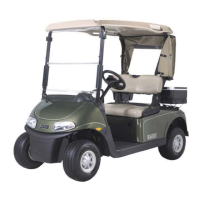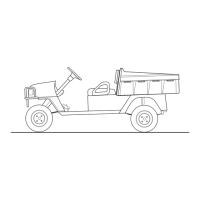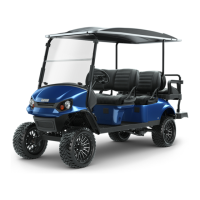OPERATION AND SERVICE INFORMATION
Page 11
Owner’s Manual and Service Guide
Read all of Manual to become thoroughly familiar with this vehicle. Pay particular attention to all Notes, Cautions and Warnings
cle (see GENERAL SPECIFICATIONS for vehicle
weight) and load. Lock the park brake and secure the
vehicle using ratchet tie downs.
SERVICE AND MAINTENANCE
To reduce the possi-
bility of severe inju-
ry or death from
improper servicing techniques:
Do not attempt any type of servicing
operations before reading and under-
standing all notes, cautions and warn-
ings in this manual.
Any servicing requiring adjustments to
be made to the powertrain while the
engine is running must be made with
both drive wheels raised and vehicle
properly supported on jack stands.
To reduce the possibility of engine dam-
age, never operate vehicle at full throttle
for more than 4 - 5 seconds while vehicle
is in a ‘no load’ condition.
Wear eye protection when
working on the vehicle. Use
extra care when working
around batteries, or using sol-
vents or compressed air.
To reduce the possibility of causing an
electrical arc, which could result in a bat-
tery explosion, turn off all electrical
loads from the battery before removing
battery wires.
Wrap wrenches with
vinyl tape to reduce the
possibility of a dropped
wrench ‘shorting out’ a battery, which
could result in an explosion.
Reduce the possibility of accidental
starting by removing and grounding
spark plug wires and disconnecting bat-
tery at negative terminal before servic-
ing.
The electrolyte in a battery is an acid
solution which can cause severe burns
to the skin and eyes. Treat all electrolyte
spills to the body and eyes with extend-
ed flushing with clear water. Contact a
physician immediately.
Any electrolyte spills should be neutral-
ized with a solution of 2 teaspoons (10
ml) sodium bicarbonate (baking soda)
dissolved in 1 quart (1 liters) of water
and flushed with water.
Aerosol containers of battery terminal
protectant must be used with extreme
care. Insulate metal container to reduce
the possibility of can contacting battery
terminals which could result in an explo-
sion.
It is in the best interest of both vehicle owner and service
technician, to carefully follow the procedures recom-
mended in this manual. Preventative maintenance,
applied at recommended intervals, is the best guarantee
for keeping the vehicle both dependable and economical.
This vehicle will give years of satisfactory service, provid-
ing it receives regular maintenance. Refer to the Periodic
Service Schedule for appropriate service intervals (Ref
Fig. 13 on page 12). Refer to Lubrication Points for
appropriate lubrication locations (Ref Fig. 31 on page
19).
To prolong vehicle life, some
maintenance items must be ser-
viced more frequently on vehicles used under severe
driving conditions such as extreme temperatures,
extreme dust/debris conditions, frequent use with
maximum load.
To access powertrain for routine maintenance, lift or
remove seat. For major repair, refer to appropriate Tech-
nician’s Repair and Service Manual.
Some service procedures may require the vehicle to be
lifted. Refer to LIFTING THE VEHICLE for proper lifting
procedure and safety information.
SERIAL NUMBER LABEL LOCATION
Two serial number and manufacture date code label are
on the vehicle. One is placed on the body below the
driver side seat. The other is located on the chassis
under the seat.
Design changes take place on an ongoing basis. In order
to obtain correct components for the vehicle, the manu-
facture date code, serial number and vehicle model must
be provided when ordering service parts.

